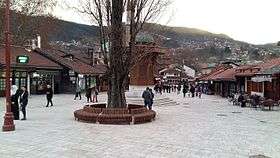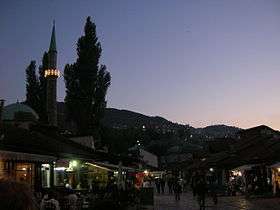Baščaršija
| Baščaršija | ||||||
|---|---|---|---|---|---|---|
| ||||||
| Country | Bosnia and Herzegovina | |||||
| Time zone | CET (UTC+1) | |||||
| • Summer (DST) | CEST (UTC+2) | |||||
| Area code(s) | +387 | |||||
Baščaršija (Cyrillic script: Башчаршија; pronounced [baʃ.tʃǎr.ʃi.ja]) is Sarajevo's old bazaar and the historical and cultural center of the city. Baščaršija was built in the 15th century when Isa-Beg Isaković founded the town.[1] The word Baščaršija derives from the Turkish language. The word "baš" which is "baş" in Turkish literally means "head", in some contexts however also "primary", "main", "capital" and "čaršija" which is "çarşı" in Turkish means "bazaar" or "market".[2] Due to the large fire in the 19th century, today Baščaršija is half the size that it once was.
Baščaršija is located on the north bank of the river Miljacka, in the municipality of Stari Grad. On Baščaršija there are several important historic buildings, such as the Gazi Husrev-beg Mosque and sahat-kula. Today Baščaršija is the major tourist attraction of Sarajevo.[3]
History
Before the arrival of the Ottomans in the largest settlement on Sarajevo field was the village square Tornik, which was located at the crossroad of the roads where today is the Ali Pasha's Mosque. Baščaršija was built in 1462 when Isa-Beg Isaković built the Ishaković han, in addition to its many shops. At that time, most of the inhabitants of Sarajevo lived in the vicinity of the Emperor's Mosque. Therefore, Isa-Beg Isaković built a bridge across the Miljacka to focus the main Sarajevo suburb and a new economic center of the city, Baščaršija.
Around the main entrance, the Bazerdžani čaršija was formed. The čaršija Kazaz is situated to the west, and to the north sit both the čaršija Sedlar and Sarača. The most significant buildings constructed during this period are the mosques. Baščaršija's famous mosque was built by Havedža Durak in 1528, and Gazi Husrev-beg built his mosque in 1530.
Gazi Husrev-Beg raises a madrassa, a library, a haniqah, the Gazi Husrev-Beg Hamam, the Gazi Husrev-Beg bezistan, the Morića Han, sahat-kula and other tourist attractions in Baščaršija. Gazi Husrev-Beg was buried in the harem of his mosque, beside the harem is the Türbe of his freed slave and the first mutevelija of his vakuf Murat-beg Tardić.
Along with Islamic places of worship erected at that time, Baščaršija is also location of Old Orthodox Church, built sometimes during 16th century and first mentioned in Ottoman sources from 1539, and also first Sephardi temple called Old Synagogue which is built between 1581 and 1587. Just next to the Old Synagogue (Bosnian: Stari Hram = Old Temple) some time later was built New Synagogue (Bosnian: Novi Hram = New Temple). However today entire Jewish community uses latest erected synagogue, Ashkenazim synagogue just across the Miljacka river, while both Old and New synagogue buildings are used as Jewish cultural centers. Now, building of the New Synagogue was donated by Jewish community to the city of Sarajevo and serves as gallery named "Novi Hram" ever since, meanwhile Old Synagogue building is turned into home for the Jewish Museum of Bosnia and Herzegovina, and is considered to be the finest exhibition space in the whole of ex-Yugoslavia.[4]


Also during 16th century a number of commercial facilities was built, such as bezistans, hans, and caravanserais. Sarajevo was an important center of trade in the Balkans and had three bezistans (today the Gazi Husrev-Beg and Brusa bezistans are still standing). There were colonies of Venetian and Ragusan traders, and Baščaršija had approximately 12,000 commercial and craft shops. After the earthquake in 1640 and several fires in 1644 and 1656, Sarajevo was 1697 burned and devastated by the troops of Prince Eugene of Savoy. Travel writer Evliya Çelebi wrote:
- " The čaršija has in everything, one thousand and eighty stores that are a model of beauty. The čaršija is very attractive and built according to plan."
The city of Sarajevo didn't еxpand significantly until the 19th century. With the Austro-Hungarian occupation in 1878, foreign architects wanted to re-build Sarajevo into a modern European city. A fire contributed to this process; it destroyed parts of the Stari Grad, and that is how the well-known boundary between Baščaršija and the street Ferhadija was made.
During the Anti-Serb riots of Sarajevo in June 1914, violent mobs looted and vandalized several Serb-owned shops in Baščaršija as well as other parts of the city.

With the liberation of Sarajevo in 1945 after the Second World War, a committee decided that the market should be gradually demolished, believing that it had no role in a modern city. However, the plans were cancelled, and the buildings were left standing.[5][6]
Important buildings
- Emperor's Mosque
- Gazi Husrev-beg Mosque
- Gazi Husrev-Beg Hamam
- Gazi Husrev-Beg bezistan
- Morića Han
- Sahat-kula
- Old Church
- Old Synagogue (Stari Hram or Old Temple), home of the Jewish Museum of Bosnia and Herzegovina
- New Synagogue (Novi Hram or New Temple), home of the "Novi Hram" gallery
- Vijećnica
See also
| Wikimedia Commons has media related to Baščaršija. |
References
- ↑ http://roker.bloger.hr/post/bascarsija/1118045.aspx
- ↑ http://www.sarajevo.ba/ba/stream.php?kat=103
- ↑ http://wikimapia.org/1004828/bs/Ba%C5%A1%C4%8Dar%C5%A1ija-Stari-Grad-Sarajevo
- ↑ "The Jewish Museum - Museum of Sarajevo" (.html). muzejsarajeva.ba (in English and Bosnian). Museum of Sarajevo. Retrieved 2 September 2016.
- ↑ "Archived copy". Archived from the original on 2011-01-14. Retrieved 2011-03-17.
- ↑ http://kudsevdah-ljubljana.com/index.php?option=com_content&view=article&id=95:historija-sarajevske-baarije&catid=49:zanimivosti&Itemid=67
Coordinates: 43°51′32″N 18°25′48″E / 43.859°N 18.430°E


.jpg)

